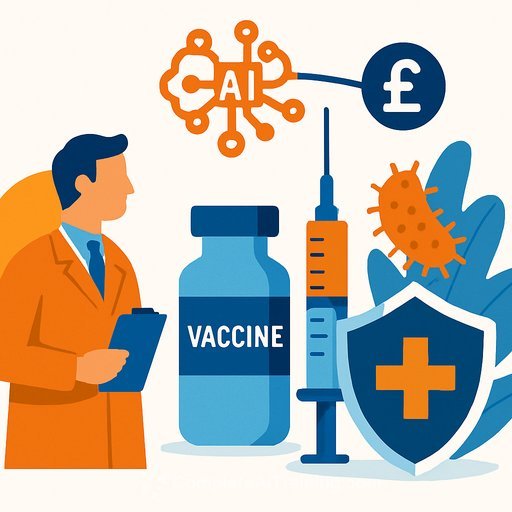AI-generated antimicrobial peptides show clinical promise against resistant bacteria
Antibiotic resistance keeps raising the bar for clinical care. Infections that were once routine now threaten standard procedures. The University of Pennsylvania reports a practical shift: an AI system called AMP-Diffusion that designs antimicrobial peptides (AMPs) with strong activity against drug-resistant pathogens while maintaining low toxicity to human cells.
The core result is straightforward. The system generated 50,000 peptide candidates in silico, prioritized them with a second model, and then validated a focused set in vitro and in vivo. Most tested peptides killed bacteria-including hospital-grade resistant strains-without harming mammalian cells. In mice, efficacy matched established last-resort drugs such as polymyxin B and levofloxacin, with no observed side effects.
Why this matters
Antimicrobial resistance is now a major pressure on health systems worldwide. Faster discovery cycles and new mechanisms of action are critical. Peptides, which disrupt bacterial membranes, give bacteria fewer evolutionary routes to escape compared to small molecules that hit single protein targets.
For context on the global burden and urgency, see the WHO overview of antimicrobial resistance: WHO: AMR.
How AMP-Diffusion works
AMP-Diffusion uses a diffusion model to generate amino acid sequences. Like image generators that convert noise into coherent images, this model converts random sequence noise into plausible peptides after learning a data-driven map of protein space from large natural protein datasets.
To down-select at scale, the team paired AMP-Diffusion with APEX, a ranking model that scored candidates for antimicrobial potential while preserving sequence diversity and filtering out near-duplicates of known peptides.
From 50,000 designs to in vivo validation
The pipeline moved from computational design to synthesis and testing. Out of 50,000 generated sequences, 46 were synthesized. Over three-quarters showed antimicrobial activity in vitro, including against difficult, drug-resistant strains commonly seen in clinical settings.
Mechanistically, these peptides compromise bacterial membranes-by forming pores, altering permeability, or upsetting electrochemical balance-leading to rapid cell death.
Toxicology screens against red blood cells and mammalian tissues showed limited cytotoxicity, suggesting useful selectivity. In a murine skin abscess model, treatment outcomes were comparable to polymyxin B and levofloxacin, and the mice tolerated therapy without side effects.
A collaborative pipeline
This work merges two strengths at UPenn: the de la Fuente Lab's expertise in mining nature for antibiotics and the Chatterjee Lab's focus on designing therapeutic peptides with AI. Together they built an end-to-end workflow that travels from noise to novel sequence to validated lead.
Speed and hit rates that change the economics
Traditional screening campaigns can take years to produce a few viable leads. AMP-Diffusion compresses ideation and triage into days, then feeds a small, diverse set into the wet lab. A hit rate above 75% among synthesized peptides is well above typical small-molecule library screens, implying fewer cycles and lower cost to reach animal studies.
Caveats and next steps
The current model is based on earlier diffusion architectures. Adopting more modern diffusion frameworks or integrating protein language models could improve control over properties like activity, toxicity, and stability.
Training data are biased toward antibacterial peptides. Broader, better-labeled datasets will be needed to generate antivirals, antifungals, or antiparasitics. Further, translation will require work on pharmacokinetics, protease resistance, formulation, and manufacturing scale-up.
What this means for research teams
Generative models now credibly propose functional peptide sequences that survive first-pass in vitro screens and early in vivo tests. For translational groups, this supports a shift from exhaustive library screening to iterative AI-driven design with targeted experimental validation.
Practically, consider integrating a diffusion-based generator with property predictors for MIC, hemolysis, serum stability, and solubility; enforce diversity constraints; and track uncertainty estimates to guide which candidates move to synthesis. Early inclusion of PK/PD assays, resistance passage experiments, and immunogenicity screens will reduce downstream surprises.
Key numbers at a glance
- 50,000 peptides generated in silico
- 46 synthesized for wet-lab testing
- >75% showed antimicrobial activity in vitro
- Comparable efficacy to polymyxin B and levofloxacin in a murine abscess model
- Low toxicity to red blood cells and mammalian tissues; no side effects observed in mice
Broader applications
The same framework could adapt to peptides for oncology, autoimmunity, and potentially viral indications, contingent on balanced, high-quality training sets and property-specific conditioning. The path forward is model improvement, data curation, and tight coupling with rapid synthesis and assay loops.
Further reading
Upskill your team
If you are building generative pipelines for therapeutics, see curated AI courses by role: Complete AI Training: Courses by Job.
Your membership also unlocks:






